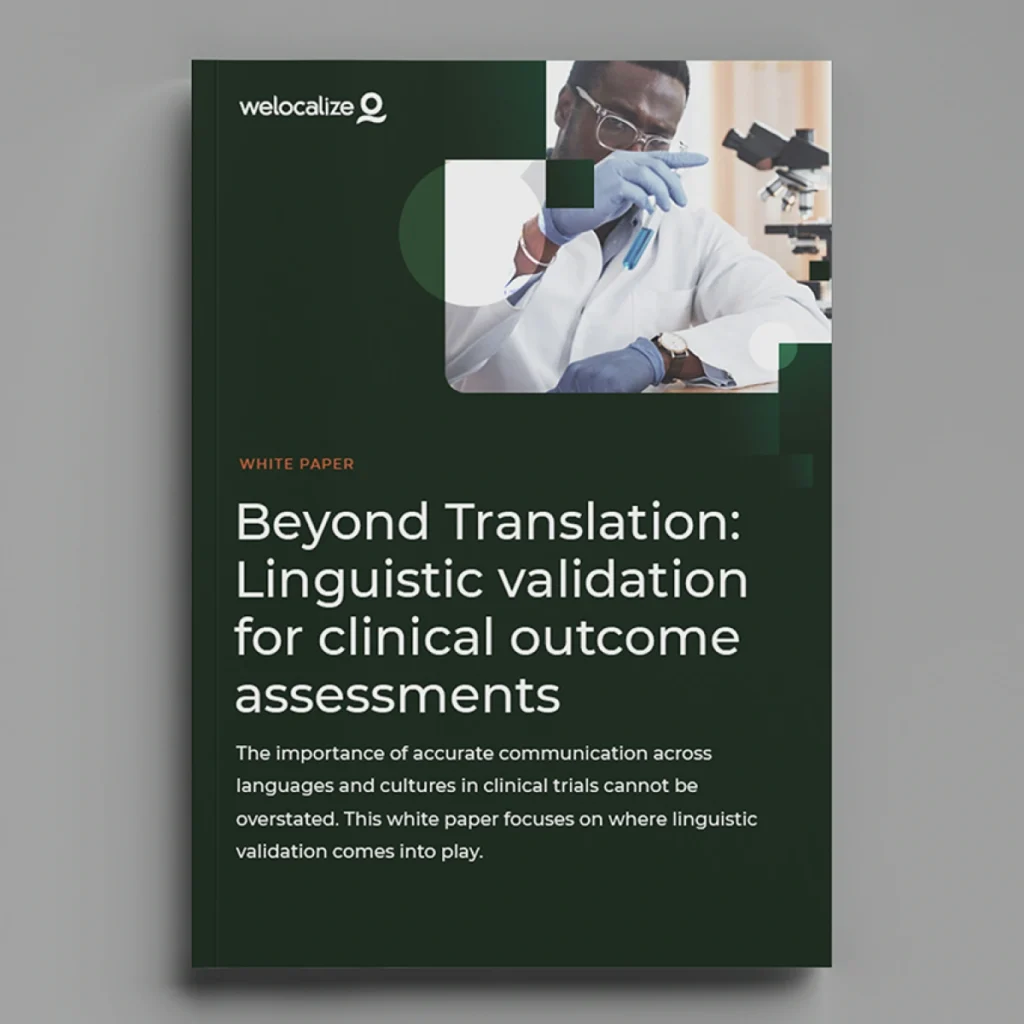How FDA and EMA Shape Linguistic Validation in Clinical Research
As clinical research becomes global, understanding how to meet regulatory requirements from major bodies like the FDA is essential.

Linguistic validation is crucial in clinical research, ensuring the accuracy and cultural appropriateness of patient-reported outcomes across diverse populations. As clinical research becomes more global, understanding how to meet regulatory requirements from major bodies like the Food and Drug Administration (FDA) and the European Medicines Agency (EMA) is essential.
While not always explicitly required, linguistic validation supports compliance by aligning with patient-centricity, data integrity, and international standards. Here’s how it plays a critical role in multinational clinical trials and best practices for ensuring compliance.
What is Linguistic Validation?
Linguistic validation goes beyond translation. It’s a rigorous process that ensures Clinical Outcomes Assessments (COAs)—which include patient-reported outcomes (PROs), clinician-reported outcomes (ClinROs), and performance outcomes (PerfOs)—are accurately adapted for different languages and cultural settings. The goal is to maintain the intended meaning and relevance across regions, ensuring consistency in patient responses regardless of their linguistic or cultural background.

YOU MIGHT LIke…
Linguistic Validation for COAs
Accurate communication across languages in clinical trials cannot be overstated. This white paper focuses on where linguistic validation comes into play.
Why Linguistic Validation Matters for Regulatory Compliance
While not explicitly mandated, linguistic validation aligns closely with regulatory requirements from agencies such as the FDA and EMA. Here’s how it supports compliance:
- Patient-Centricity: Regulatory bodies emphasize patient-centric approaches in clinical trials. Linguistic validation ensures study materials are culturally relevant and easy to understand, promoting better patient engagement and accurate data collection.
- Data Integrity: Clinical trial data must be comparable to aggregate and analyze data from different countries. Linguistic validation minimizes cultural and linguistic biases, enhancing data reliability and validity.
- International Standards and Best Practices: Although linguistic validation is not legally required, evidence of its use is often requested by Institutional Review Boards (IRBs) and Independent Ethics Committees (IECs). Compliance with standards like ISO 17100:2015 for translation services ensures quality and reliability.
Navigating FDA and EMA Requirements
Both the FDA and EMA recognize the importance of appropriate translation and adaptation of COAs for target populations:
- FDA Guidance: The FDA’s guidelines for PROs stress the need to demonstrate that translated instruments are culturally suitable for the target population, ensuring accurate capture of patient experiences.
- EMA’s Reflection Paper: The EMA highlights the need for linguistic validation in its guidance on PRO measures in oncology studies, emphasizing the comparability of data across different cultural settings. This guidance can also apply to other therapeutic areas.
Best Practices for Linguistic Validation in Multinational Clinical Trials
Implementing best practices for linguistic validation can help clinical research organizations (CROs) navigate complex regulatory landscapes:
- Conduct a Translatability Assessment: Evaluate the source document to identify cultural or linguistic challenges before translating. This proactive step can prevent issues later.
- Use Back Translation and Harmonisation: After the initial translation, conduct a back translation to the original language. This helps identify discrepancies and ensures the translated version maintains the original meaning.
- Pilot Cognitive Debriefing: Test translated materials with a small group from the target population to assess understandability and cultural relevance, ensuring the instrument captures the same information across different regions.
- Engage Native-Speaking Clinicians: Having healthcare professionals who speak the target language review, the translation can verify its accuracy within the therapeutic context.
- Implement Quality Assurance and ISO Standards: Following ISO 17100:2015 and incorporating stringent quality control measures can enhance the validity and acceptance of linguistic validation processes.
Strategies for CROs to Ensure Compliance
For CROs managing global clinical trials, ensuring compliance through linguistic validation should be a strategic focus. Here’s how to optimize the process:
- Partner with Experienced Providers: Working with language service providers specializing in life sciences can streamline linguistic validation. These providers bring expertise in regulatory expectations, quality standards, and best practices.
- Adopt a Hybrid Approach to Translations: While universal translations can be cost-effective, they may lack cultural specificity. A hybrid approach—starting with a universal translation and adapting it for specific regions—balances budget and cultural nuances.
- Document the Linguistic Validation Workflow: Even if not legally required, CROs should document the entire process, including quality assurance steps and compliance with international standards. This helps meet regulatory scrutiny and ensures a robust defense if questions arise.
Linguistic Validation: A Strategic Asset for Global Clinical Trial Success
In today’s global clinical trial landscape, linguistic validation is more than just a procedural step—it’s a strategic tool that supports regulatory compliance and enhances trial outcomes.
Clinical research organizations can more effectively navigate regulatory requirements by aligning with patient-centric principles, safeguarding data integrity, and adhering to international standards. Partnering with a linguistic validation specialist ensures compliance and improves data quality, patient experiences, and the overall success of global clinical trials.
Linguistic validation may not always be a legal requirement, but its benefits make it indispensable for any multinational trial. By integrating these best practices and strategies, CROs can confidently meet regulatory expectations while conducting meaningful clinical research across diverse populations.
 Siobhan Hanna
Siobhan Hanna Erin Wynn
Erin Wynn
 Nicole Sheehan
Nicole Sheehan Kimberly Olson
Kimberly Olson Matt Grebisz
Matt Grebisz Christy Conrad
Christy Conrad Chris Grebisz
Chris Grebisz Dan O’Brien
Dan O’Brien